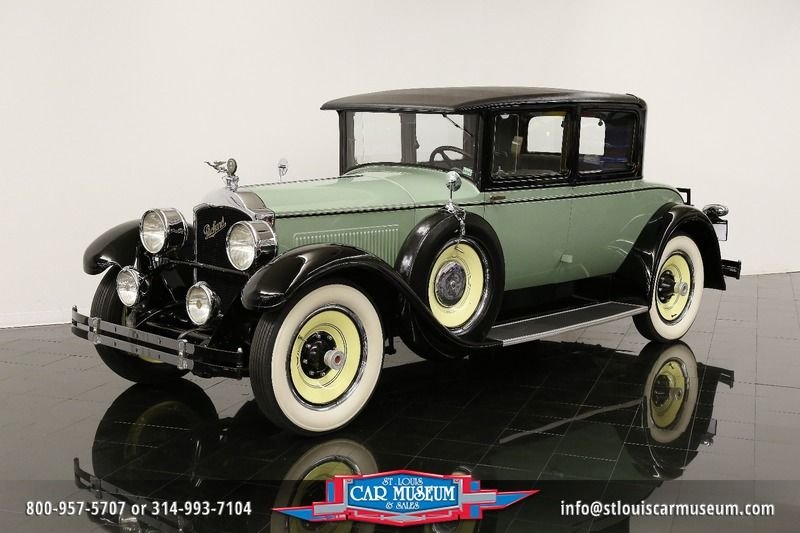Drivetrain
Chassis
Body

In 1921, Packard introduced the Single Six, a smaller, less expensive alternative to the big, V-12, Twin Six. Packard refined the Single Six and lowered its price over the next few years. The Second Series, introduced in December 1923, had four-wheel brakes and claimed 20-mpg economy. It easily outsold the new Single Eight introduced at the same time due to its reliability and it's thousand-dollar difference in price.
The Third Series six, introduced in February 1925, did even better and contributed to more than three-quarters of Packard sales. The Fourth Series six-cylinder Packard, now called simply "Six," was introduced in August 1926. The engine benefited from a new "Turbo-Head" with redesigned combustion chambers that boosted horsepower to 81. New aluminum pistons and a redesigned intake manifold also contributed to the improved performance. This was also the first production automobile to use a hypoid differential, which, allowed for a lower ride height. The Packard Six was really doing well, outselling the Eights four to one and resulting in a four-month waiting list. The final iteration of the Packard Six (until a much smaller and less expensive model was built in 1937) was the Fifth Series Six, introduced on July 1, 1927. It came on 126" and 133" wheelbases and labeled as Series 526 and 533. The 81 horsepower, 288.6 cubic inch displacement engine was refined with better lubrication, an oil filter and four-point mounting. With nearly 22,000 built, the Six still outsold the Eights by a wide margin.
One of less than fifteen known to survive, this unusual 1927 Series 533 Four Passenger Coupe is finished in the same paint scheme that Packard featured in its sales literature for closed cars in 1928. With its chassis number of 126713, it was one of the first Fifth Series Sixes built and was likely built in late 1927. The four-passenger coupe body style is often referred to by today's collectors as a Victoria coupe. It is a very sporty two-door body design with suicide-style front doors, seating for four and a rear, bustle back trunk built into the body-a feature that was used only on this particular body style. It was the second, most expensive six-cylinder Packard built with abase-selling price of 2,685.00. This particular example is being offered from the estate of a prominent local collector. While its early history is unknown, it was purchased about fifteen years ago and has been stored in a climate-controlled, museum-like environment. During his ownership, this Packard was always well maintained and used sparingly. As an older restoration of a very original car, this 1927 Packard has a great look about it. The exterior paint is older but well preserved. It has the usual wear one would expect from an older repaint.
The paint has an overall, even but mellowed gloss to it and still shines well. It is likely that this vehicle was never completely disassembled and has only been repainted once. This car is not perfect by any means but displays itself nicely. There is a broken casting on the dash as well as some other small defects. The windows are also a little stiff going up and down. The body is rock solid. The doors open and close like those of a bank vault with that solid sound that one expects to hear from a Packard of this era. The doors fit the body well and properly align with the cowl and rear quarters. Likewise, the hood aligns properly with the radiator shell and cowl. The fenders are just as smooth underneath as they are on the top and do not appear to have even been damaged or repaired. This is really a very solid and well-preserved car. The lavish, cloth interior inside this coupe is believed to be original. It shows just the right amount of wear from being almost 90 years old, yet, is very clean and very presentable. The front passenger seat hinges forward to allow access to the rear bench seat. Behind the driver's seat is a storage box that one could use for storing their hats or to hide other objects of importance. The seats, door panels and headliner are very well preserved and have a great original look to them. The dashboard and the wood trim items have a nice, mellowed glow to their finish. The gauges are clean and clear. The chrome plating on the original Packard drum headlamps, the radiator shell, bumpers and other accessories was likely redone many years ago when the car was repainted and today, remains very clean. Under the hood, the original Packard engine remains clean and well maintained. The engine has its original and correct distributor, Packard carburetor and vacuum fuel delivery system. On the firewall, the Bijur chassis oiling system is in place with its control lever mounted inside ,underneath the dashboard.
The engine starts easily and runs well. As expected, it is smooth and quiet-a signature feature of the early Packard six cylinder engines. The underneath of the car appears largely original. This particular 1927Series 533 Packard Four Passenger Coupe is well equipped with many factory accessories including disc wheels, dual, side-mounted spare tires with covers rear view mirrors, a Packard moto-meter temperature gauge mounted on a Goddess of Speed mascot, dual, rear Packard tail lights, and a rear mounted luggage rack. Aftermarket accessories including a pair of Trippe front driving lights, auxiliary rear taillights, and a set of air-horns, mounted underneath the hood. Packard Sixes from 1925 to 1928 are recognized by the Classic Car Club of America (CCCA) as Full Classics and eligible for all CCCA meets and CARavans. The Fifth Series Packards are well respected by collectors and appreciated for their agile driving qualities, ease of maintenance, and overall reliability.

1927 Packard
533 4-Passenger Coupe
Quick Specs
Description
In 1921, Packard introduced the Single Six, a smaller, less expensive alternative to the big, V-12, Twin Six. Packard refined the Single Six and lowered its price over the next few years. The Second Series, introduced in December 1923, had four-wheel brakes and claimed 20-mpg economy. It easily outsold the new Single Eight introduced at the same time due to its reliability and it's thousand-dollar difference in price.
The Third Series six, introduced in February 1925, did even better and contributed to more than three-quarters of Packard sales. The Fourth Series six-cylinder Packard, now called simply "Six," was introduced in August 1926. The engine benefited from a new "Turbo-Head" with redesigned combustion chambers that boosted horsepower to 81. New aluminum pistons and a redesigned intake manifold also contributed to the improved performance. This was also the first production automobile to use a hypoid differential, which, allowed for a lower ride height. The Packard Six was really doing well, outselling the Eights four to one and resulting in a four-month waiting list. The final iteration of the Packard Six (until a much smaller and less expensive model was built in 1937) was the Fifth Series Six, introduced on July 1, 1927. It came on 126" and 133" wheelbases and labeled as Series 526 and 533. The 81 horsepower, 288.6 cubic inch displacement engine was refined with better lubrication, an oil filter and four-point mounting. With nearly 22,000 built, the Six still outsold the Eights by a wide margin.
One of less than fifteen known to survive, this unusual 1927 Series 533 Four Passenger Coupe is finished in the same paint scheme that Packard featured in its sales literature for closed cars in 1928. With its chassis number of 126713, it was one of the first Fifth Series Sixes built and was likely built in late 1927. The four-passenger coupe body style is often referred to by today's collectors as a Victoria coupe. It is a very sporty two-door body design with suicide-style front doors, seating for four and a rear, bustle back trunk built into the body-a feature that was used only on this particular body style. It was the second, most expensive six-cylinder Packard built with abase-selling price of 2,685.00. This particular example is being offered from the estate of a prominent local collector. While its early history is unknown, it was purchased about fifteen years ago and has been stored in a climate-controlled, museum-like environment. During his ownership, this Packard was always well maintained and used sparingly. As an older restoration of a very original car, this 1927 Packard has a great look about it. The exterior paint is older but well preserved. It has the usual wear one would expect from an older repaint.
The paint has an overall, even but mellowed gloss to it and still shines well. It is likely that this vehicle was never completely disassembled and has only been repainted once. This car is not perfect by any means but displays itself nicely. There is a broken casting on the dash as well as some other small defects. The windows are also a little stiff going up and down. The body is rock solid. The doors open and close like those of a bank vault with that solid sound that one expects to hear from a Packard of this era. The doors fit the body well and properly align with the cowl and rear quarters. Likewise, the hood aligns properly with the radiator shell and cowl. The fenders are just as smooth underneath as they are on the top and do not appear to have even been damaged or repaired. This is really a very solid and well-preserved car. The lavish, cloth interior inside this coupe is believed to be original. It shows just the right amount of wear from being almost 90 years old, yet, is very clean and very presentable. The front passenger seat hinges forward to allow access to the rear bench seat. Behind the driver's seat is a storage box that one could use for storing their hats or to hide other objects of importance. The seats, door panels and headliner are very well preserved and have a great original look to them. The dashboard and the wood trim items have a nice, mellowed glow to their finish. The gauges are clean and clear. The chrome plating on the original Packard drum headlamps, the radiator shell, bumpers and other accessories was likely redone many years ago when the car was repainted and today, remains very clean. Under the hood, the original Packard engine remains clean and well maintained. The engine has its original and correct distributor, Packard carburetor and vacuum fuel delivery system. On the firewall, the Bijur chassis oiling system is in place with its control lever mounted inside ,underneath the dashboard.
The engine starts easily and runs well. As expected, it is smooth and quiet-a signature feature of the early Packard six cylinder engines. The underneath of the car appears largely original. This particular 1927Series 533 Packard Four Passenger Coupe is well equipped with many factory accessories including disc wheels, dual, side-mounted spare tires with covers rear view mirrors, a Packard moto-meter temperature gauge mounted on a Goddess of Speed mascot, dual, rear Packard tail lights, and a rear mounted luggage rack. Aftermarket accessories including a pair of Trippe front driving lights, auxiliary rear taillights, and a set of air-horns, mounted underneath the hood. Packard Sixes from 1925 to 1928 are recognized by the Classic Car Club of America (CCCA) as Full Classics and eligible for all CCCA meets and CARavans. The Fifth Series Packards are well respected by collectors and appreciated for their agile driving qualities, ease of maintenance, and overall reliability.
1927 Packard
533 4-Passenger Coupe
Also For Sale

1953 Packard
Caribbean
Designed by Richard Teaque with influence from the 1952 Pan American experimental sports car, the new 1953 Packard Caribbean was a mid-year introduction to the market. Clean, understated lines rea...
$99,900

1956 Packard
Caribbean
Style in the 1950s was abundant; a time when real design studio ideas found their way to the end product. The Packard Caribbean was introduced in 1953 as the top-of-the-line convertible model, bui...


